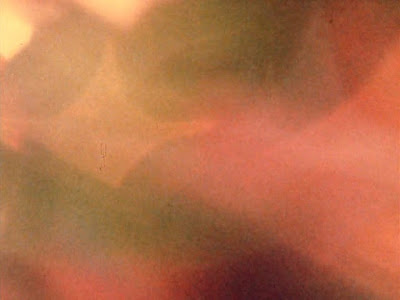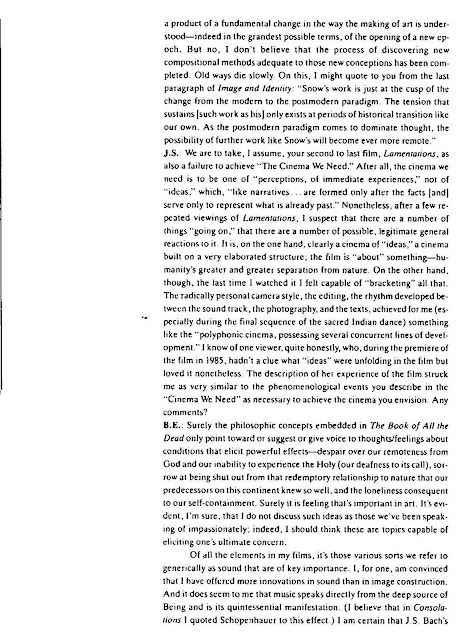Showing posts with label Bruce Elder. Show all posts
Showing posts with label Bruce Elder. Show all posts
26.9.13
ACINEMA
11:19 AM
---
"...Lyotard, by way of contrast, advocates an 'acinema'
that does not trade in fixed identities (not even formal identities, of
the sort involved in visual rhymes and repeated figured) and
recognizable situations (that is, situations whose doubling existence
repeats what we know of the world, to ensure that it can be folded back
into the world)... It
is a cinema of intense agitation. “Cinematography” means writing
movement: in learning cinematography in film schools, one acquires a
training in discriminating between “good” and “bad” movements: good
movements are commodifiable movements, valued in a strict capitalist
sense—good movement, Lyotard suggests in his article “Acinema” is
deemed valuable “because it returns to something else . . . it is thus
potential return and profit.” Scenes that are “dirty, confused,
unsteady, unclear, poorly framed, overexposed” are deleted—it
eliminates all impulsional movement (whether representational or
abstract) that escapes identification and recognition and will not give
itself for reduplication. Against that, Lyotard’s vanguardism
advocates a cinema that does not depend on unity and balance, but on a
constant movement of rupture. Lyotard’s rethinking of Freud’s dynamic
model of energy rejected the privilege that Freud attached to the
discharge of energy and the return to the homeostatic condition. Energy
(arousal), for Lyotard, is delight, bliss—so he reconceived jouissance,
taking it not as discharged, not as having as its objective to return
us to the calmed state (that foretells the thanatic extinction of
desire), not as a rétournement, but, rather, as a pure activity, a détournement
(cf. sublimation, in the literal sense) that misspends energy
purposefully. Acinema, Lyotard notes, by writing with movements that go
beyond the point of no return, spills “the libidinal forces outside
the whole, at the expense of the whole (at the price of the ruin and
disintegration of this whole).” Borrowing from Artaud’s ideas on the
theatre of cruelty, Lyotard suggests that the purpose of the acinema is
to make victims of its spectators/auditors, by generating anxiety,
agitation, or emotional turmoil—for it is on the side of intensity, on
the side of life against death. Rather than good (unified and
reasonable) forms, the dynamics of acinema, presented to the
immobilized viewer/auditor, “give[s] rise to the most intense agitation
through its fascinating paralysis.” The excess of movement renders a
cinema’s medium opaque: it does not offer us that hope that one can see
through it to that harmonious presence for which the conventional
cinema, in its reactionary nostalgia, yearns. Thus, again, acinema is a
savage cinema, for in it, the medium asserts itself, brutally, as its
images and sounds relay unresolvable intensities. Attending to it, one
comes apart, as by a knife, under its divers movements. Without
identifying (naming) what is happening on screen, we sense it
viscerally—feeling it in our muscles and our bodies."
- Bruce Elder's Acontecimientos 2012 for Lumière
---
from Wide Angle vol. 2, no. 1978
---
Labels:
ACINEMA,
Bruce Elder,
Jean-François Lyotard,
Lumière,
Wide Angle
|
2
comments
3.1.12
Rhythm & Blues
5:03 PM
---
(From The Films of Stan Brakhage... by Bruce Elder)
---
(Unconscious London Strata by Stan Brakhage)
Labels:
Bruce Elder,
Le Marteau Sans Maître,
Pierre Boulez,
Stan Brakhage,
The Films of Stan Brakhage in the American Tradition,
Unconscious London Strata
|
1 comments
3.2.11
The Text of Light
7:14 PM
"All that is is light." - Dun Scotus Erigena
"To see a world in a grain of sand." - William Blake
These the primary impulses while working on this film. It is dedicated to Jim Davis who showed me the "first spark" of refracted film light.
These the primary impulses while working on this film. It is dedicated to Jim Davis who showed me the "first spark" of refracted film light.
-Brakhage's program notes for The Text of Light
---
(From The Text of Light by Stan Brakhage; courtesy Anthology Film Archives)
---
(From Canto LXXIV by Ezra Pound)
(From Canto LXXXVII by Ezra Pound)
---
(From The Films of Stan Brakhage... by Bruce Elder)
---
See Robert Grosseteste's On Light here...
---
(From The Text of Light by Stan Brakhage; courtesy Anthology Film Archives)
---
Labels:
Anthology Film Archives,
Bruce Elder,
Ezra Pound,
John Scotus Erigena,
Robert Grosseteste,
Stan Brakhage,
The Cantos of Ezra Pound,
The Text of Light
|
0
comments
4.9.10
Waking the Dead
2:04 PM
As previously mentioned, Bruce Elder’s The Book of all the Dead has loomed large on my personal horizon for some time now, one of a handful of ambitious cinematic sequences that capture my fascination in ways that little else does. God willing in the near future I’ll have the opportunity at MoMA to scale the great heights of a few other works of a like-nature (if not like-mind), but unfortunately as to Elder’s creation itself for the foreseeable future that great hunger is somewhat satiated through peripheral testaments like the following very engaging 1988 Millenium Film Journal interview between Jim Shedden and Elder.
---
Labels:
Bruce Elder,
Consolations: Love is an Art of Time,
Jim Shedden,
Lamentations: A Monument to a Dead World,
Millenium Film Journal,
The Book of All the Dead
|
0
comments
Subscribe to:
Comments (Atom)
























































